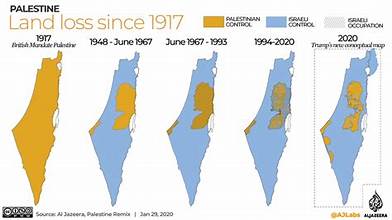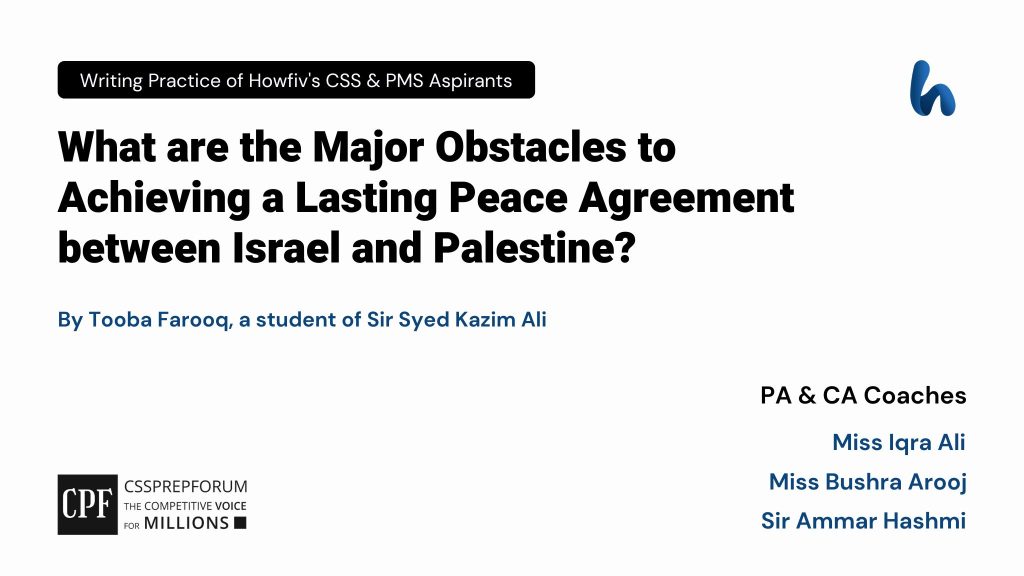Obstacles to Achieving Peace between Israel and Palestine | Daily Writeup | Opinions
The following article of CSS Pakistan Affairs is solved by Tooba Farooq under the supervision of Howfiv’s Pakistan Affairs Coaches. She learnt how to attempt 20 marks question and essay writing from Sir Syed Kazim Ali, Pakistan’s best CSS and PMS English essay and precis teacher with the highest success rate of his students. This solved past paper question is attempted on the pattern taught by Sir to his students, scoring the highest marks in compulsory and optional subjects for years, and uploaded to help aspirants understand how to crack a topic or question, how to write relevantly, what coherence is, and how to include and connect ideas, opinions, and suggestions to score the maximum.

Outline
1- Introduction
2- A bird eye view of the Israel-Palestinian conflict
3- A timeline of peace negotiations between Israel and Palestine
4- Current situation of the ongoing war between Israel and Palestine
5- What are the major obstacles in achieving a lasting peace agreement between Israel and Palestine?
- ✓ Two-state solution: a threat to Israel’s security
- ✓Mutual distrust
- ✓Expansion of illegal Israeli settlements
- ✓Future of Jerusalem
- ✓Future of Palestinian refugees
- ✓ Non-seriousness of mediating powers
6- Conclusion

Answer to the Question
1- Introduction
The state of Israel was born in war as a result of the Balfour Declaration, which called for the division of Palestine into two states: one for Jews and one for Arabs. Israel declared itself as a separate state, which started the conflict between the newly formed state Israel and the owner of the land Palestine. The surrounding Arab countries were also against the presence of a Jewish state in Arab land. Thus, there were four Arab-Israel wars, two Intifada by Palestinians and several peace talks between Israel and Palestine. Unfortunately, there has never been a long-term peace solution owing to various factors such as Israel’s view of the two-state solution as a threat to security, the prevalence of mutual distrust, the expansion of illegal Israeli settlements, and the future of Jerusalem. All this has contributed to a never-ending conflict between the two states.
2- A bird eye view of the Israel-Palestinian conflict
Before discussing factors that are hindering long-lasting peace between Palestine and Israel, it is imperative to discuss how and why the conflict started. The state of Israel was born after World War 2; the United Nations proposed a plan to divide Palestine into two states: one for the Arabs and the other for the Jews. Despite all the surrounding Arab countries and Palestinians living on the lands rejecting the plan, Israel still declared itself a state on May 15 1948, which started a never-ending conflict between Israelis and Palestinians. The chronic conflict continued for years after the fourth Arab-Israel war; the recognition of Israel by Egypt made Palestine feel betrayed, which ultimately gave rise to Hamas, a non-state organisation organisation fighting against Israelis to stop illegal settlement in Palestinian land. Despite the chronic conflict that followed, there was a series of peace talks between both, yet none assured long-lasting peace in the region.
3- A timeline of peace negotiations between Israel and Palestine
| UN Resolution 242 => 1967 |
| Camp David Accords => 1978 |
| Amid the First Intifada, Arafat acknowledged Israel’s right to exist => 1988 |
| Madrid Conference => 1991 |
| Oslo Accords => 1993 |
| Oslo II Accords => 1995 |
| Camp David => 2000 |
| Various frameworks for peace are developed after the Second Intifada => 2002-2003 |
| Israel’s unilateral withdrawal from Gaza and some settlements in the West Bank => 2005 |
| Olmert’s Peace Offer => 2008 |
| Direct negotiations between Israel and the Palestinian National Authority => 2010 |
| Abraham Accords 2020; Trump’s “Deal of the Century” => 2020 |
4- Current situation of the ongoing war between Israel and Palestine
As mentioned above, peace negotiations between Israel and Palestine were never long-lasting. Recently, Hamas launched a deadly attack on Israel on October 7, 2023; consequently, Israel declared war against Hamas. Israeli forces consider Gaza, the home of Hamas, had launched violent aerial strikes and land invasions, which have resulted in more than 35,000 death tolls in the Gaza Strip as per the United Nations. Despite this, the world is striving hard to ease the tension, and efforts are being made to cease fire, but it is still a far cry.
5- What are the major obstacles in achieving a lasting peace agreement between Israel and Palestine?
There are many obstacles to the pathway to achieving lasting peace between the two countries.
- ✓ Two-state solution: a threat to Israel’s security
Israel never agreed on the United Nations Partition Plan, Resolution 181, which called for the division of Palestine into an Arab and a Jewish state because they didn’t want a neighbouring hostile Muslim state. Moreover, the current government of Israel, which is one of the most far-right led by Benjamin Netanyahu, the main motive is a state Solution with One Israel and no Palestine. The constant forceful expansion and development of Israeli settlements in the occupied West Bank clearly highlight how the aggressive designs of the Israeli government are hindering long-lasting peace agreements.
- ✓Mutual distrust
In addition to that, Four Arab-Israel wars and three Intifadas created a sense of distrust between the two countries. Whenever there is a peace negotiation, it never lasts long because either Israel or Hamas violated the terms of a peace deal. All this happens because of a lack of trust. Despite the Abraham Accords 2020, Israeli forces in 2021, on the last Friday of the month of Ramzan, attacked the Al-Aqsa mosque, mascaraed thousands of innocent worshippers, which sparked Hamas to launch an attack on Israel on October 7, 2023. Such sudden violent attacks from both sides have created a sense of mutual distrust and are hampering peace negotiations.
- ✓Expansion of illegal Israeli settlements
Moreover, the illegal expansion of Israeli settlements had added fuel to the fire. As the map shows, how Israelis have been illegally occupying Palestinian land since 1948. This illegal expansion is one of the main reasons for all wars and uprisings in Palestine; when the people are deprived of their own houses, this gives birth to an uprising and Intifada against the occupiers.

- ✓Future of Jerusalem
Also, the future of Jerusalem had always been a burning question between both countries. Jerusalem is important for Muslims, Jews and Christians, as all the three have their sacred places there. Palestinians want a state with East Jerusalem as its capital. While Israel says Jerusalem should remain its “indivisible and eternal” capital. Israel’s claim to the eastern part of Jerusalem is not recognisedrecognized internationally. In a historical move, in 2018, Trump moved the U.S. embassy to Jerusalem by recognising recognizing it as the capital of Israel, which led Palestinians to feel aggrieved.
- ✓Future of Palestinian refugees
In addition to all mentioned above, the future of Palestinian refugees is also an issue hindering the standstill of peace efforts. Palestinians have long demanded that refugees who had moved to Jordan, Lebanon, and Syria during the wars should be allowed to return. There are about 5.6 million Palestinians, among which many are living in crowded camps while most of the registered refugees are still stateless. Isr. all is firm on its decision that if Palestinian refugees must resettlement outside of the borders of the country, its borders be expanded continuously. Thus, there is no place for refugees in their own homeland.
- ✓ Non-seriousness in mediating
Last but not least, the mediating powers are often not interested or are continuously favouring one side in the conflict. The global power USA has always supported the aggressive acts of Israel and tries to portray Hamas as terrorists who are disturbing the stability of Israel state. The major news outlets of America, such as BBC and CNN, have also done the same while reporting the ongoing war between Israel and Hamas; they always portrayed Israel as a state trying to defend itself. Thus, when the mediating powers are biased, the dream of a long-lasting peace deal is seen as a distant dream.
6- Conclusion
In conclusion, Israel and Palestine had tried many times to have peace talks but they were never long lasting due to various reasons. The non-seriousness of mediating power, future of Jerusalem and illegal Israeli expansion are some main factors that had hindered peace talks. Although, Israel Palestine issue has been a long standing unresolved issue yet by implementing pertinent measures it can be resolved.

CSS Solved Past Papers’ Essays
Looking for the last ten years of CSS and PMS Solved Essays and want to know how Sir Kazim’s students write and score the highest marks in the essays’ papers? Then, click on the CSS Solved Essays to start reading them.
CSS Solved Essays
CSS Solved General Science & Ability Past Papers
Want to read the last ten years’ General Science & Ability Solved Past Papers to learn how to attempt them and to score high? Let’s click on the link below to read them all freely. All past papers have been solved by Miss Iqra Ali & Dr Nishat Baloch, Pakistan’s top CSS GSA coach having the highest score of their students.
General Science & Ability Solved Past Papers












